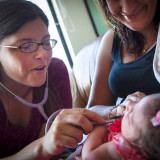At first, medicine seemed like the perfect mix for me. I love solving problems and I love teaching and I love socializing. With those brutal years of medical school and residency behind me, I could take this incredible wealth of knowledge and use it to help people. I firmly believed then, and still do, that if someone doesn't care for their body, there are only a few possible explanations. Perhaps life had treated them too badly and I'd need to help them see themselves as precious and deserving of care. Or perhaps they were just lacking the understanding of what they needed. Not knowledge. Facts don't lead to action. Understanding. Understanding is what drives us to behaviors because we can't imagine not doing them, they are so obvious.
But I gradually realized that time didn't allow for real teaching. We left that for nurses, medical assistants, diabetic educators, and peer mentors. As patient after patient came back from diabetic education stuffed with facts but still not understanding, I became increasingly frustrated. The diabetic education came too late, their pancreas was shot already, and it hadn't inspired them the way really high quality teaching can. Everyone meant well, but just like many struggling students I'd helped over the years, my patients weren't learning what they needed in the current way it was presented.
So when I set out to design my own practice, I made sure to have an hour with every patient. For large families, I'd block an entire morning or afternoon for their well child checks and we'd spend several hours together. At first, the hour felt incredibly long. I didn't know how to fill the time. So I just listened a lot. While listening, I discovered that patients had been talked to a lot and told a lot but never had a full hour to just chat with a physician. I'd always thought I was compassionate and understanding. But having most of an hour to listen was the difference between learning from a short commercial and learning from an hourlong class. Sure, there are some great commercials out there, but you can't say you really understand a topic after watching a commercial about it.
I'll always remember that first year in my practice as being incredibly humbling. I learned how complex patients are and how little we as physicians really understand about their day to day. I developed a new rule for myself. If a person's behavior doesn't make sense, it's because we aren't taking the time to understand. All behavior is completely rational in a particular situation. People are making the best choices they can given their past trauma, available resources, and current understanding.
Slowly over time, I began spending some of that hour teaching. I tried to take what I learned in medical school, the beautiful complexity of the human body, and teach it in a way that made sense to my patients who may not have finished high school but had a lot of life experience and survival smarts. Our body is designed for survival. Any ancient humans whose bodies and brains were less well-honed died out. We're descended from the survivors.
I didn't just teach about the pathophysiology and pharmacology of diabetes and the dangers of smoking. I taught about neurobiology and how the brain helps us survive but not necessarily thrive and how we can work well with our brain to care for our body. I often pulled out Netter's Anatomy from medical school or took people to the back room to look under a microscope. We explored how smoking or self harm had helped them survive in the past, causing their survival-brain to think those habits were necessary going into the future. While eating foods high in sugar and fat can help people cope in difficult situations, it also leads to health problems.
One of my patients dragged in her husband, a burly, cheerful working man whose past medical record was littered with labels such as “non-compliant” and “argumentative.” I started with the same opening I’ve used since medical school, “What brings you in today?”
“My wife!” he replied, laughing. “I don’t have much use for doctors but my wife keeps dragging me to them.”
We chatted for a bit about their years together before I brought the conversation back to why she was worried. She explained that his diabetes numbers had been high for years and he wouldn’t follow his doctors’ recommendations. After some more conversation, I asked his permission to explain diabetes to him the way I would to a medical student. He said he’d heard it all but was willing to let me say my piece. So I started with a drawing of a cell and explained what a cell is and how many we have in our body and what they do. Then I drew a channel in the cell membrane with a “lock” next to it. Insulin is the key that unlocks the door and lets in the sugar your cell needs.
“Our house is 100 years old,” I said. “Sometimes the locks get sticky and we have to use graphite for them to work again.” He nodded in understanding. “When you get diabetes, the lock is sticky, the insulin tries to unlock it but can’t so the sugar doesn’t get in. Your cell doesn’t know what’s going on, but it’s starving! It starts sending out panic signals to all the other organs of the body. ‘Help! I’m starving! I need energy!’ So your whole body is trying to help. Your pancreas sends out more insulin, your liver starts spitting out stored sugar…” I continued through the whole process, the spiral of endocrine issues kicked off by insulin resistance.
“Woah,” he commented. “That’s pretty dramatic.”
“Yes it is!” I agreed. “Diabetes affects every organ in your body. And all that sugar in your blood is pouring over every part of your body.” I went on to explain how the sugar damages the small blood vessels and nerves, causing pain, blindness, and difficulties in the bedroom. Once he was thoroughly wrapped up in the story, we moved into the resolution. How each lifestyle change would help all these stressed-out organs. How a few different medications could work to stop the out of control spiral of problems.
“Do you have any questions?” I asked.
“Yeah,” he replied. “What do you think I should do first?”
It can be intimidating to start teaching patients when we're used to only having a minute to reel off a quick fact or two. But think back to being a fourth-year medical student helping out a third year, an intern with a medical student, an upper-level with an intern. You didn't just tell them what to prescribe, you told them why. You didn't make them memorize that someone with untreated sleep apnea can develop right-sided heart failure, you explained why. And while that was based on what we learned in medical school, it was shared in language that's easily adjusted for a non-medical audience.
Most physicians know what diagnoses they treat most frequently so start translating those into teachable lessons. You don't have unlimited time so consider recording the explanation for the patient to watch while waiting for you. When you see them, you can answer questions and discuss what they learned, just like any teacher would after showing an educational video.
Or consider a group visit in which you provide the education to multiple patients at once. With the help of an assistant, you can follow certain billing guidelines and easily bill for appointments for all the patients who attend. Or try training your staff in these more detailed explanations. My first medical assistant had lots of other careers before medical assisting and while she had a limited science background, she loved learning. I was fresh out of residency so I sat with her, as I had my medical students, teaching her about the conditions we were treating in our patients. I loved listening in on her conversations with patients as she passed on that knowledge. All the extra time spent teaching her shined through.
Patients come to us because they want help. If there wasn’t some level of trust, they wouldn’t be seeing us to begin with. When we take the time to teach, we demonstrate both our authority on the subject and our concern for the patient: we care enough to take the time to help them. These patient interactions then build our sense of purpose as physicians, taking us from one of the gears in a giant medical machine into a professional whose wisdom makes a difference in the lives of our patients.
What's something you recently taught a patient? Share your tales of education in the comments.
Robin Dickinson, MD is a board-certified family physician who teaches clinical skills to first-year students at Rocky Vista University. She created the first pre-medical curriculum for kids, hosts a podcast for young people who want to be physicians, consults neurodiverse families and individuals, and founded the only free clinic and the first DPC practice in her hometown. You can find her at robindickinsonmd. Dr. Dickinson is a 2021–2022 Doximity Op-Med Fellow.
Image by Alphavector / Shutterstock







